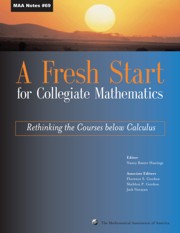Book contents
- Frontmatter
- Preface
- Contents
- Introduction
- Background
- Theme 1 New Visions for Introductory Collegiate Mathematics
- Theme 2 The Transition from High School to College
- Theme 3 The Needs of Other Disciplines
- Theme 4 Student Learning and Research
- Theme 5 Implementation
- Theme 6 Influencing the Mathematics Community
- Ideas and Projects that Work: Part 1
- Ideas and Projects that Work: Part 2
Ideas and Projects that Work: Part 1
- Frontmatter
- Preface
- Contents
- Introduction
- Background
- Theme 1 New Visions for Introductory Collegiate Mathematics
- Theme 2 The Transition from High School to College
- Theme 3 The Needs of Other Disciplines
- Theme 4 Student Learning and Research
- Theme 5 Implementation
- Theme 6 Influencing the Mathematics Community
- Ideas and Projects that Work: Part 1
- Ideas and Projects that Work: Part 2
Summary
Just as our students say, “Show me an example,” participants at the conference, Rethinking the Preparation for Calculus, asked for examples of ideas and projects that work. The authors of the five papers in this section discuss some of the larger issues connected with curricular materials that they have developed. The next section, “Ideas and Projects: Part II,” contains fifteen short, descriptive papers for particular projects.
In this section, Doris Schattschneider describes an alternative one-year college calculus course that integrates a review of precalculus concepts to help students, who have taken precalculus but are not prepared for calculus, succeed in calculus. Bill Fox reiterates a common theme in this volume—the need to work with our colleagues in other disciplines—as he describes a new college algebra course that is based on modeling and applications. Dan Kalman describes a course in elementary mathematical models for the general education student that is a hybrid of two approaches, college algebra and liberal arts math. Brigitte Lahme, Jerry Morris and Elias Toubassi present a case for integrating laboratories into a precalculus course. Gary Simundza describes the “Fifth Rule” for helping students understand mathematical concepts: the direct experience of mathematical processes.
A course that integrates precalculus review with calculus takes careful planning, but does not require fundamental changes in calculus content or teaching style. An integrated approach can be used in calculus courses anywhere in the spectrum from traditional to reform, and in special calculus courses such as those designed for majors in business or the biological sciences. […]
- Type
- Chapter
- Information
- A Fresh Start for Collegiate MathematicsRethinking the Courses below Calculus, pp. 283 - 284Publisher: Mathematical Association of AmericaPrint publication year: 2006



